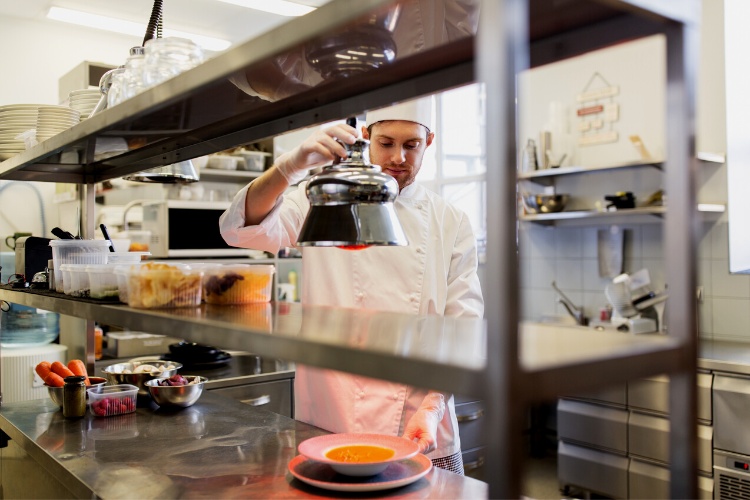Properly heating food is not just a task; it's a critical responsibility for food handlers because it ensures you serve your customers high-quality, enjoyable food, meet the food safety standards of your local health department, and foster trust with your community.
At the end of the day, following all food safety best practices lets your customers know that you prioritize their health and safety and ensure they have a good experience at your establishment.
Properly preparing certain foods means cooking or heating them to an internal temperature high enough to kill potential pathogens, thus reducing the risk of foodborne illnesses. It also means ensuring your foods do not remain in the temperature danger zone for too long.
Heating foods to a safe temperature is a crucial step in the food preparation process, and it applies to both the initial cooking process and reheating any leftovers.
Read on to learn more about properly heating foods to protect them from the temperature danger zone. In this blog, we’ll cover:
What is the two-hour rule?
How do I properly heat food for safety?
How do I safely reheat leftover food?
What is the two-hour rule?
Food preparation spaces are chaotic by nature. However, it is essential that you keep track of how long time and temperature control for safety (TCS) foods remain at room temperature during the preparation and service process.
You should never leave TCS foods out at room temperature for more than two hours. After approximately two hours, foods enter the temperature danger zone, and pathogens can grow rapidly, increasing the risk of foodborne illness to anyone who consumes that food. If your food preparation space is 90°F or hotter, you actually only have an hour before food left out at room temperature becomes unsafe.
Once you prepare food to the proper temperature, your kitchen should have equipment to help hold the dish at the correct temperature until you or your teammate serves it. This equipment can include hot-holding units, heat lamps, or even insulated containers. Leftovers must be properly cooled and stored in the refrigerator or freezer as soon as possible.
To protect your customers, you must discard any perishable foods left out at room temperature for over two hours (or one hour if the temperature is 90°F or more).1
How do I properly heat food for safety?
Properly heating food kills pathogens and prevents them from lingering in the temperature danger zone for too long. While the aesthetics of a meal may seem important, the internal temperature is actually what matters most to food safety.
Many TCS foods have specific internal cooking temperature requirements. You should always measure the temperature of your foods by inserting a calibrated thermometer into the thickest part of each food item before sending them out for service.2
Review the chart below for some examples of safe minimum internal temperatures provided by the U.S. Department of Agriculture (USDA).2,3
|
Product |
Minimum Internal Temperature + Rest Time |
|
Beef, pork, veal and lamb steaks, chops, roasts |
145 °F (62.8 °C) and allow to rest for at least three minutes |
|
Ground meats |
160 °F (71.1 °C) |
|
Ground poultry |
165 °F (73.9 °C) |
|
Ham, fresh or smoked (uncooked) |
145 °F (62.8 °C) and allow to rest for at least three minutes |
|
Fully cooked ham (to reheat) |
Reheat cooked hams packaged in USDA-inspected plants to 140 °F (60 °C) and all others to 165 °F (73.9 °C). |
|
Poultry (breasts, whole bird, legs, thighs, wings, ground poultry, giblets, and stuffing) |
165 °F (73.9 °C) |
|
Eggs |
160 °F (71.1 °C) |
|
Fish and shellfish |
145 °F (62.8 °C) |
|
Leftovers |
165 °F (73.9 °C) |
|
Casseroles |
165 °F (73.9 °C) |
How do I safely reheat leftover food?
Even after you cook food to a safe internal temperature, pathogens can grow in leftovers–even if you properly cool and store them for later use. You can combat these pathogens by properly reheating leftovers to the correct temperature.
According to the USDA, food should always be reheated to an internal temperature of 165°F or “until hot and steaming.”2 Similar to the initial cooking process, always use a thermometer to check a food’s internal temperature before serving or consuming it.
If you are reheating food in a microwave, always cover the food and ensure the dish rotates throughout the process to ensure even heating. After reheating a dish, allow the food to stand for at least two minutes.2
Practice good food safety by properly heating food
Properly heating food is essential to preventing foodborne illnesses that can result in hospitalization, death, and the permanent closure of your establishment. If you’re still uncertain about what it means to properly heat food or other food safety fundamentals, consider taking a food handler training to refresh your knowledge and boost your confidence. Remember, heating food to its safe minimum internal temperatures keeps you in compliance with food safety regulations and ensures you are serving up dishes that are both safe and enjoyable for your customers!
Sources:






.png)

.png)
